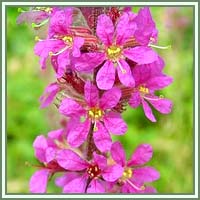PURPLE LOOSESTRIFE
Lythrum salicaria
Common name: Purple Loosestrife
Latin name: Lythrum salicaria
Other names: Spiked Loosestrife, Sage Willow, Purple Willow Herb.
Family: Lythraceae
Habitat: Purple Loosestrife is native to Europe, Asia, northwest Africa, and southeast Australia. It can be found near fresh water such as ponds, lakes and rivers.
Description: Purple loosestrife is a herbaceous perennial plant. It can reach a height of 1.5 meters. It forms clonal colonies, sending numerous erect stems from a single root mass. They are reddish-purple and tough, and often appear to be woody near the base. The leaves are simple and lanceolate, opposite or in whorls of three. The flowers are also reddish-purple in color, with six petals, arranged on a long spike. The fruit is a small capsule with multiple minute seeds. Flowering lasts throughout the summer.
Parts used: All aerial parts.
Useful components: Salicarin, tannins, volatile oil, mucilage, sterols.
Medicinal use: Traditional medicine has used Purple Loosestrife in treatment of dysentery, internal hemorrhages, nose bleeds, stomach pains and vaginitis. It is considered to have good astringent and tonic properties, and can be an effective remedy against diarrhea and dysentery, and can significantly help in cases of heavy menstrual and intermenstrual bleeding. It has a tonic effect on the bowels, colon, gall bladder, liver and kidneys. Its beneficial results as an eye-wash are yet to be explored. Purple Loosestrife could act as a remedy against certain eye disorders. Used externally, it can be applied in form of a poultice to wounds, external ulcers and eczema.
Safety: Some herbs could react with certain medication. Therefore, it is advisable to consult your doctor before consumption of any herb.

